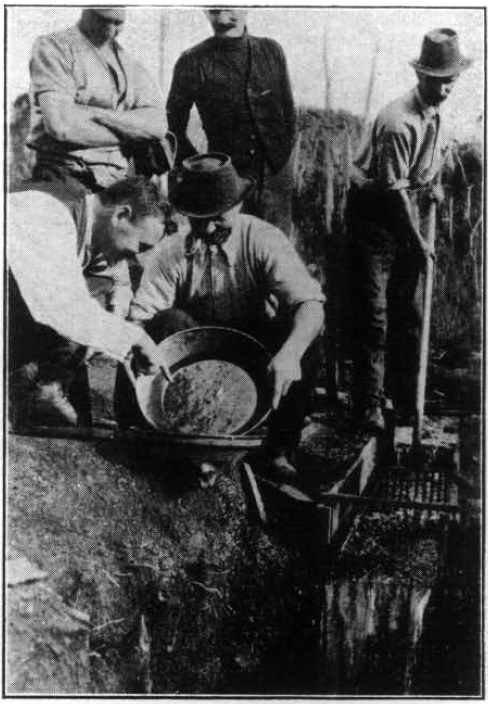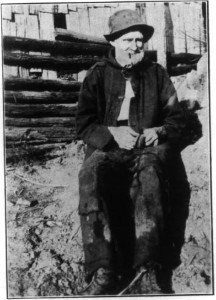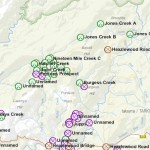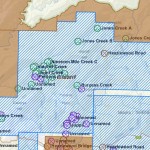Did you know that, in the first half of the 20th Century, if you owned a fountain pen, you most likely wrote using a tiny little piece of Tasmania? Fountain pen tips were made of gold, but gold and its alloys are too soft to write with: the tip or nib wears too quickly and would be too expensive to replace. Osmiridium was the answer.
For some time in the early 20th Century, Tasmania was the world’s largest producer of osmiridium, or ‘ossie’ as the miners called it. Osmiridium is a natural alloy of the metals osmium and iridium, in the platinum group. It’s often found together with gold and other platinum-group metals.
The Bald Hill, Wilson River and Adamsfield deposits produced the bulk of the Tasmanian ‘metal’. South Africa and Russia were also producing osmiridium, although of much finer grain than the Tasmanian metal, and only useful for smelting. Tasmanian osmiridium commanded much higher prices, because the larger proportion of our material was ‘point metal’: the perfect size to use for fountain pen nibs (thanks John Boots!).

Tasmanian locations where osmiridium has been found. Courtesy of MRT (data) and Google Earth (image).
What is this pesky contaminant?
The 1880s saw a period of intense gold mining and prospecting activity in the Corinna goldfields. At this time the gold miners were finding a white, hard metal that washed with their gold, and was very difficult to separate in their panning dish: the density of osmiridium is 22 g/cm3, compared to 19 for gold. The added cost to refine it meant that miners were penalised for any osmiridium content. They hated it and took pains to clean out the gold as well as they were able, tossing the osmiridium away.
The man credited with developing the mining of osmiridium in Tasmania is James McGinty, of McGinty Nugget fame. Thirty years earlier, during the time he spent digging for gold in the Corinna goldfields, he had found the largest gold nugget ever discovered in Tasmania. Some time after this, he moved to the Victorian goldfields.
He seems to have kept the pesky contaminating white metal in mind. He eventually returned to Tasmania, realising it had potential. Already in his 70s, he started mining for it and trying to find a market. By 1908 he was rewarded, and buyers of osmiridium were setting up in Tasmania. McGinty’s workings were in the area of modern-day Nineteen Mile Creek, east of the Savage River mine, and the main creek he worked still bears his name. He died at the Nineteen Mile Creek workings in 1920 at the age of 83, and is buried in the Pioneer Cemetery.
At approximately the time that the Bald Hill and other northwest deposits were becoming depleted, the Adamsfield deposit was discovered and a rush ensued. By mid-1925 prospecting work was going on in earnest.
Minor finds were also made on the south coast near Rocky Boat Harbour, on the west coast south of Strahan, and near Maydena, but as far as I can tell, none of these were of any significance.
Osmiridium in Tasmania today
No large-scale exploration for osmiridium or other platinum-group metals is carried out at present, and as far as I’m aware there are no current mining leases or exploration licences for osmiridium or platinum-group metals granted.
The Adamsfield area, while inside the World Heritage Area, is classed as a Conservation Area and not a National Park. A permit is needed from Parks and Wildlife in order to fossick and prospect in there. From what I’ve heard in the grapevine, licences are granted, and their main concern is to know who’s doing what.
If you prospect for gold in the Corinna area on the west coast, chances are you’ve come across osmiridium already. Even west of Corinna, gold deposits contain a proportion of tin, chromite and osmiridium that has travelled from much further east. Most of that ossie is probably from the Bald Hill Area.
- Occurrences of Osmiridium in the Bald Hill area (green symbols). Map courtesy of MRTmap.
- Tenements around the Bald Hill area of osmiridium deposits. Map courtesy of MRTmap.
The best areas to head to are probably those around Bald Hill. The Heazlewood River is said to be Ok, but I haven’t tried it personally. It has good road access, which few other locations do. The Savage River for a few kilometers below Nineteen Mile Creek was historically very productive for gold and ossie, but it’s remote and hard to reach.
A lot of this area is covered (at the time of writing) by EL50/2011, held by Aus Tin Mining Ltd. According to the prospecting regulations, you should ask for permission before prospecting there. I haven’t tried and have no idea whether they’re happy to allow prospectors or not.
Some resources for your research:
- W.H. Twelvetrees. The Bald Hill Osmiridium Field, 1914.
- C. Brown. A Review of the Osmiridium Mining Industry of Tasmania, 1919.
- A. McIntosh Reid. Osmiridium in Tasmania, 1921.
- P.B. Nye. Osmiridium in Tasmania, 1928.
- P.B. Nye. The Osmiridium Deposits of the Adamsfield District. 1929.
- C.A. Bacon. Notes on the history of mining and exploration at Adamsfield. 1992.
Did you find this useful? If you like the content at Apple Isle Prospector, feel free to get in contact, or leave a comment. If you enjoyed this article, then let others know by sharing it on Facebook or liking our Facebook or Twitter pages:





I\’m attending the Easter Gemboree at Ulverstone, and wish to go ossie fossicking whilst in Tassy. I\’ll be on the isle for a month, with 4wd and caravan. Any suggestions? regards, Garry.
Hi Garry,
I guess it depends how energetic you feel. Heading to the Nineteen Mile Creek area would probably be my first choice, but I haven’t been there myself and I can’t say how easy or hard the walk is. If you’re after just a bit, then I hear you can pan some at the Heazlewood River bridge. The gold in the Corinna area often has the odd bit of ossie in it as well. Other areas include The Castray River, Wilson River, Mt. Stewart. All of them are hard to get to. The Savage River carries a fair amount, but again, it’s hard to get to. You might try Melba Flats, between Rosebery and Zeehan, but it’s pretty scrubby.